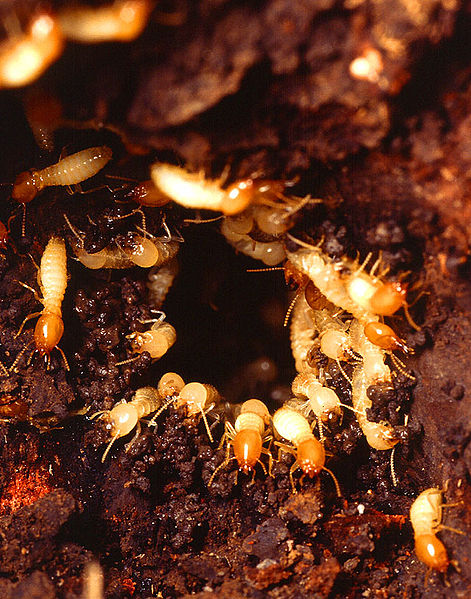SERVICE REQUEST?
Fill out the form below.
Find our nearest location
Your Local Office

Formosan Subterranean Termite
Attribution: Giancarlodess via WikiCommons
Size:
Alates, or swarmers, are about 1/2-inch overall length, including the wings.
Color:
Alates are yellowish brown
Behavior:
Formosan termite colonies begin small, with a single pair of reproductives – a king and a queen – but may grow to contain several million individual termites. Initially, the king and queen establish the new colony by producing 15 to 30 eggs. Two to four weeks later, the nymphs hatch and are nursed by the reproductives. The queen deposits a second batch of eggs one to two months later. The first batch of nymphs takes over the nursing responsibilities. The first new termites produced are workers. As the colony grows, soldiers are produced and finally, three to five years after the colony is started, winged reproductives are produced. A mature queen can live more than 15 years and deposit as many as 1,000 eggs per day. A mature colony may produce more than 20,000 reproductive alates each year. Alates, or swarmers, do not reproduce in their original colonies. They swarm out of the colony by the thousands along with alates from nearby colonies. Each alate attempts to pair with an alate of the opposite sex from a different colony. Few survive this quest. Those that are successful become the kings and queens of the new colonies. Swarming usually follows a warm, rainy day in late spring or early summer, most often in May and June, and typically occurs in the evening between twilight and midnight.
In addition to huge underground colony systems – often 10 times larger than those of other subterranean species – Formosan termites build carton (mud) nests within the walls and other enclosed spaces of a structure. These nests may serve as residences for tens of thousands of individual termites and as reservoirs of moisture to sustain them during dry periods. Found primarily in tropical and sub-tropical climates, Formosan termite colonies have been established all over Hawaii, in Charleston, South Carolina, and along the Gulf Coast, including several parts of Florida; Galveston, Texas; New Orleans and Baton Rouge, Louisiana; and Auburn and Mobile, Alabama. Individual Formosan sites have also been discovered in places such as San Diego, California; Atlanta, Georgia; and Memphis, Tennessee. Formosan termites are considered more vigorous and aggressive than other subterranean species. Because Formosan termite colonies can contain several million individuals, they can cause damage at an accelerated rate, with a mature colony causing significant damage to a structure in a relatively short time. Formosans are also more difficult to control than native species when using traditional liquid soil treatments. Unlike other subterranean whose colonies are almost exclusively underground, Formosans can establish secondary aerial nests with no connection to the ground. Called carton nests, they are usually found inside walls, under cabinetry, and in other enclosed voids within a building.
Formosan subterranean termites are difficult to control once they have invaded a structure. For that reason, prevention should be the first line of defense. If a Formosan colony is found within a structure, quick action is required to minimize potential structural damage. When the soil of an infested structure is treated to stop their entry, the individuals already in the structure may form an independent nest above ground and avoid the treated soil. Prevention:
- Use wood pressure treated with preservatives that make it more resistant to termite attack.
- Correct any sources of excess moisture – leaky plumbing, air conditioning condensation, poor drainage, inadequate ventilation – to deny the termites an additional moisture supply.
- Contract with a professional pest control company to regularly inspect your home to detect a termite infestation and then treat it accordingly.
- Eliminate all wood-to-soil and rigid foam board-to-ground contact. Remove any wood debris.
Control options:
- Place a termiticide barrier in the soil between the termites and the wood structure.
- If the structure is already infested, locate the carton nests for localized treatment, or fumigate the entire structure.
- Above ground bait stations may also be necessary if the structure is already infested.
- Control aerial colonies by correcting excess moisture conditions and by fumigation or installation of above-ground termite baiting stations.
Family Name:
Coptotermes formosanus
Read What Our Clients
Are Saying
My Terminix tech Scott is the best! He is professional, courteous and absolutely thorough about his job. Thank you for sending such a blessed tech to my house. Hamlet, NC
This letter is to say how pleased we are here at Morreene West Apartments with your services. We are very pleased with the technician, Christopher. He does a great job. Durham, NC
Terminix has consistently offered our apartment complex reliable, competent service. We are completely satisfied with their knowledgeable representative who is always punctual and does a superior job for us every time. Chapel Hill, NC
I would like to take the time to thank you for giving us such great service here at Carver Pond Apartments. Your Pest Technician Christopher Mitchell has provided us with excellent service over the last few months. Christopher is such a great help to us in providing helpful information so that we can better serve our residents here at Carver Pond. Durham, NC
SERVICE REQUEST?
Fill out the form below.